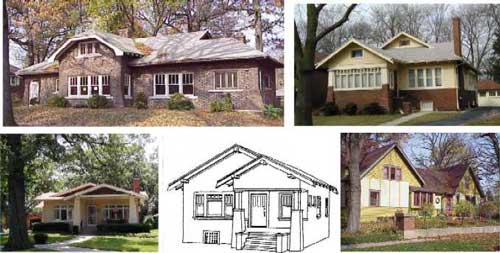


|
American Architecture StylesMODERN STYLES High Style Architecture | 19th Century Vernacular | Modern Style | 20th Century In the first decades of the 20th century, some architects began designing buildings in styles that bore no reference to prior historical architectural styles. The earliest of these, the Craftsman and the Prairie School styles, looked to other areas of inspiration than the past for stylistic ideas. With the Prairie School style in particular, there was intent to have architecture fit more into the rhythm of the surrounding natural landscape. As the century progressed, modernism took hold, first with the International style and then with later variations. In the Craftsman, Prairie, and modernist styles, the pure expression of materials, without unnecessary ornamentation, was the dominant design feature. CRAFTSMAN AND CRAFTSMAN BUNGALOW The Craftsman style grew out of the English Arts and Crafts Movement, which had an emphasis on natural materials and a high level of craftsmanship. The style is generally characterized by: low-pitched roofs with deep overhanging eaves, exposed rafter ends, decorative brackets or knee braces under shallow gable roofs, dormers, and a deep front porch. Windows are frequently double hung sash with three panes in the upper sash and one in the lower. Craftsman detailing was frequently combined with the bungalow form, and Craftsman Bungalows, inspired by the work of California architects Greene and Greene, were widely published in architectural journals and popular home magazines of the day. Plans were often included in articles about the style, and the Craftsman Bungalow became one of the most popular house styles during the teens and twenties. Although they were built into the 1920s, Craftsman homes were particularly popular between 1901 and 1916, when the architect and furniture maker Gustav Stickley published his magazine, The Craftsman.
The Prairie School style of architecture is frequently regarded as America's first indigenous residential architectural style. It takes inspiration not from historical precedents but from the Midwest's most characteristic natural feature, the prairie. Hence, the horizontality of the Midwest landscape is emphatically expressed in Prairie houses. Identifying features of Prairie School architecture include low-pitched roofs with wide overhangs, flat stucco or brick wall treatment, casement windows (frequently leaded) clustered in horizontal bands, and brick detailing in geometric patterns. Prairie School buildings generally have a massive quality, as if rooted to the earth.
In the 1920s and 30s, Art Deco and Art Moderne achieved great popularity as modern architectural styles. Although somewhat different in their overall appearance, both styles share stripped down forms and geometric-based ornament.
The International Style was originally developed in Europe in the 1910s and 1920s by: Le Corbusier, Walter Gropius, and Ludwig Mies van der Rohe. Some of the practitioners of the style emigrated to the United States and to Chicago, carrying with them the functional approach to architecture that was practiced at the Bauhaus, Gropius' school of modern design. Gropius, who settled near Boston, Mies van der Rohe, who practiced in Chicago, and Richard Neutra, who worked in California, began a modernist tradition that influenced the work of countless other architects whose designs regularly won awards and were featured as Architectural Record houses of the year. International Style residential architecture is characterized by: flat roofs, planar wall surfaces, and a lack of any applied ornamentation. These homes are generally low in profile but may stand two or even three stories, are asymmetrical and geometric in form, and often incorporate a considerable amount of glass in their designs. They are elegant in their attention to proportion and detailing.
The term Contemporary is somewhat imprecise, but for that reason has been used to classify a style dating from the mid-1940s and later that incorporates some of the tenets of modernism, but often with less rectangular form and occasionally with some ornament.
Special Feature Publication: "ARCHITECTURAL STYLES AND TYPES IN BEVERLY HILLS-MORGAN PARK"
|
||||||||||||||||||||||||||||||||||||||||||||||
| home | company background | woodcarving & sculpture | period furniture custom built-in's | services | commissioning process museum/historical affiliations | educational services | craftsmen links sitemap | search |
|||||||||||||||||||||||||||||||||||||||||||||||
Artisans of the Valley Hand Crafted Custom Woodworking Stanley D. Saperstein Eric M. Saperstein Our studio and showrooms are open by appointment. Please call ahead so we don't miss you! (609) 637-0450 Fax (609) 637-0452 e-mail: woodworkers@artisansofthevalley.com |




